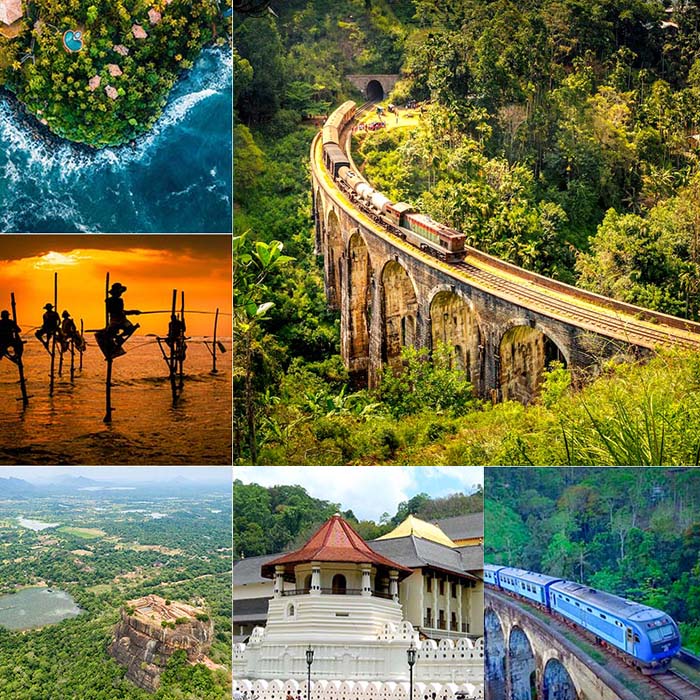
Sanura
Often referred to as the “Pearl of the Indian Ocean,” Sri Lanka is a tiny island nation with a dazzling variety of natural landscapes. It has just a land area of approximately 65,000 square kilometers but is packed with wildlife, rolling green hills, golden beaches, foggy mountains, and lush rainforests. Sri Lanka has one of the most affluent ecosystems in Asia thanks to its tropical environment, augmented by the warm waters of the Indian Ocean and its proximity to the equator.
A landscape of many faces
One of the most remarkable features of Sri Lanka is the richness of its landscapes within a comparatively compact space. Plains give way to middle highlands, which hold peaks like Pidurutalagala and venerated Adam’s Peak. Renowned for cloud forest, waterfalls, and tea plantations, these areas are cooler than those close to the seacoast.



In contrast, the lowland plains, particularly in the north and in the southeast, are home to open grasslands and dry forests in certain regions as they are dry and warm. Wet regions, which are primarily located in the southwest, are occupied by dense rainforests like the UNESCO World Heritage Site Sinharaja Forest Reserve. Mangroves, lagoons, and sandy coastlines along the coastline constitute another distinct habitat occupied by both fishing communities and wildlife.
Biodiversity and Wildlife
Sri Lanka is regarded as one of the global hot spots for diversity. Thousands of species live in its forests, grasslands, wetlands, and coastal habitats, and numerous species occur only here.
The Sri Lankan elephant, a species of Asian elephant, is one of the island’s well-known large mammals. Elephants are seen in national parks like Minneriya and Udawalawe in their natural habitat. Yala National Park, which has one of the highest leopard densities in the world, is the nation’s most popular wildlife park.
Besides these endearing creatures, Sri Lanka is also home to spotted deer, sloth bears, sambars, wild boars, and a number of primates like the purple-faced langur and toque macaque. Blue whales, sperm whales, and dolphins populate the surrounding oceans, while there are some hundreds of species of migratory birds in the wetlands.
Apart from this, Sri Lanka is also home to an amazing array of insects, amphibians, and reptiles. Some of the frogs in the rainforests are endemic, which means that they are found only in this world. The island is a snorkeler’s and diver’s paradise because of the coral reefs and seagrass beds surrounding the coasts, which serve as a sanctuary for marine life.
Forests and Flora
No less striking are Sri Lanka’s flora and fauna. Rain forests of the wet zone abound in tall trees, creepers, and epiphytes. Highland montane forests, with a cooler climate and frequently enveloped in mist, contain exotic vegetation including such rare orchids and rhododendrons.
Evergreen forest species that are adapted to seasonal driehts, such as palu, weera, and ebony, occupy the dry zone forests. Apart from serving as fish and crustacean breeding grounds, coastal mangroves shield the country from erosion and hurricanes.
Although not a natural landscape, tea gardens have actually formed the landscape of Sri Lanka from the British colony era onward. There is beauty in seeing well-tended neat green tea bushes on rolling hills.
Sacred Links Between Nature and Culture
In addition to being a source of resources and beauty, Sri Lankan nature is also linked with the spirituality and culture of the country. In order to coexist with the environment, old people and kings constructed irrigation systems that transformed dry places into productive agricultural fields.
Most of the natural sites are imbued with religious heritage. Adam’s Peak, or Sri Pada, is sacred to Christians, Muslims, Hindus, and Buddhists. Pilgrims ascend the mountain yearly to witness the dawn at the top. Anuradhapura’s Bo tree, an ancient, living tree with a well-documented planting date, is reported to be a sapling of the tree where the Buddha attained enlightenment.
In order to create a balanced ecosystem, ancient villages were designed around tanks, man-made reservoirs, and forests, and traditional farming methods frequently respected natural cycles.
National Parks and Protected Areas
To safeguard its wildlife and their habitats, Sri Lanka has an enormous web of national parks, nature reserves, and sanctuaries. Some of them include Yala, Wilpattu, Horton Plains, Sinharaja, Udawalawe, Bundala, and Minneriya.
The central highland Horton Plains National Park is renowned for the “World’s End,” a cliff that is precipitous and provides spectacular views. Besides protecting endangered species, the Sinharaja Forest Reserve is a vital watershed area. The Ramsar Convention recognizes Bundala National Park as a wetland conservation area and a haven for migratory birds.
In addition, these areas of the park are vital to ecotourism, which protects natural resources while generating revenue for bordering communities.
Threats to Nature
The Sri Lankan ecosystem is threatened by several factors though it has a rich natural heritage. Forest destruction through development activities, logging, and agriculture encroach on wildlife habitats. Human contact with wildlife, particularly contact between farmers and elephants, is on the rise because human settlements expand into wildlife habitats.
Ecosystems are also under stress caused by pollution, overfishing, and global warming. Agriculture is threatened by irregular rainfalls, and there is coral bleaching caused by increased sea temperatures which impact marine life.
Conservation Efforts
More work has been done in recent years to preserve Sri Lanka’s natural environment. The government has carried out conservation initiatives like habitat restoration, reforestation, and awareness campaigns in collaboration with regional and global organizations.
Stricter regulations are in place to stop illegal poaching and logging, and wildlife corridors are being created to lessen conflict between elephants and humans. Initiatives for ecotourism promote environmental stewardship while boosting the local economy in rural areas.
Media campaigns and educational initiatives in schools are also crucial in raising public awareness of the value of environmental preservation. A large number of young Sri Lankans actively participate in wildlife conservation, tree planting, and community clean-up campaigns.
Experiencing Nature in Sri Lanka
The Sri Lankan environment faces threats from several forces even though it possesses a wealthy natural heritage. Deforestation due to development activities, timber logging, and agriculture encroach into wildlife habitats.
Human contact with wildlife, and most notably the contact between farmers and elephants, increases as human settlements expand into wildlife habitats. Ecosystems are strained by pollution, overfishing, and global warming as well. Agriculture is threatened by irregular rainfalls, and there is coral bleaching by warm sea temperatures which impact marine creatures.